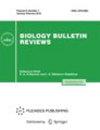[高度特化生物的进化可塑性,以类角螨为例]。
IF 0.3
4区 生物学
Q4 BIOLOGY
Zhurnal obshchei biologii
Pub Date : 2015-01-01
引用次数: 0
摘要
拟角螨是一类高度特化的植食性螨类。由于对植物寄生的适应,它们缺乏III和IV对腿,获得了细长的蠕虫状身体和独特的颌体结构。尽管高度专门化,类鼻螨表现出显著的进化可塑性,这表现在与占据各种生态位、胆形成过程、向新寄主群体过渡以及对气候变化的各种适应相关的许多形态逆转、平行和修改中。本文章由计算机程序翻译,如有差异,请以英文原文为准。
[Evolutionary plasticity of highly specialized organisms with eriophyoid mites (Acariformes: Eriophyoidea) as an example].
Eriophyoids is a group of highly specialized plant-feeding acariform mites. As a result of adaptation to phytoparasitism, they lacked III and IV pairs of legs and acquired elongated vermiform body and unique structure of gnathosoma. Despite the high degree of specialization, eriophyoid mites demonstrate remarkable evolutionary plasticity which manifests itself in numerous morphological reversions, parallelisms, and modifications associated with occupying variety of niches, processes of gall formation, transitions to new groups of hosts, and various adaptations to climate change.
求助全文
通过发布文献求助,成功后即可免费获取论文全文。
去求助
来源期刊

Zhurnal obshchei biologii
生物-生物学
自引率
25.00%
发文量
6
审稿时长
>12 weeks
期刊介绍:
Публикуются статьи по теоретическим вопросам биологии, представляющие интерес для биологов любой специальности (вопросы эволюции, экологии, общей таксономии, общей цитологии, генетики, проблемы механизмов приспособления живых организмов к условиям существования, закономерности развития организмов, бионика и т. д.), основанные на новом оригинальном фактическом материале или же подводящие итоги работы того или иного научного коллектива.
Помимо теоретических статей, помещаются рецензии на новые книги российских и зарубежных биологов, а также информация о международных конгрессах и общероссийских совещаниях по важнейшим проблемам биологии.
 求助内容:
求助内容: 应助结果提醒方式:
应助结果提醒方式:


